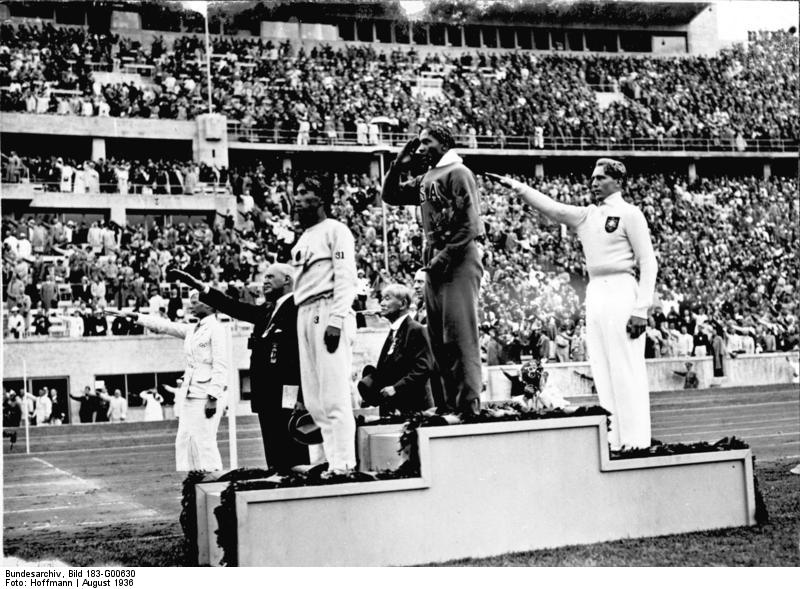Olympics and the law: The life of Carl Ludwig ‘Luz’ Long

Credit: Bundesarchiv, Bild 183-G00630 / Unknown author / CC BY-SA 3.0 de
With the Paris Olympics having reached their conclusion, Gillian Mawdsley reflects on a connection between the law and the Olympics.
How many of us have heard of Carl Ludwig “Luz” Long?
Luz was a participant in that most notorious of Olympic Games held in Berlin in the presence of Adolf Hitler in 1936. Many will be aware of the controversy caused where Jessie Owens, an African-American track and field athlete, achieved infamy by winning four gold medals at these Games. After Hitler refused to shake hands with him on 1 August 1936 following his victory in the long jump, Owens was said to have “single-handedly crush[ed] Hitler’s myth of Aryan supremacy”. Hitler had shaken hands with the German victors at the Games, leading to International Olympic Committee president, Henri de Baillet-Latour, insisting that Hitler greet every medallist or none at all. Allegedly, Hitler thereafter skipped all medal presentations.
The story of Jesse Owens and his gold in the long jump are well-known. Luz was the defeated silver medallist in that long jump. Legend, but probably not fact, has it that it was advice from Luz that led to Owens’ success following some of his poor early jumps in the competition.
Who was Luz?
Luz was born in 1913 and was a sports enthusiast from his childhood, having built himself a jumping pit at the age of 10. He practised all manner of sports until he was 16, when he joined the Leipzig Sports Club, where he specialised in the long jump (and triple jump). By 1934, he had won third place at the European Track Championships at Turin, securing a favoured status in Germany. He was a recognisable stereotype, in that he was tall, fair, blue-eyed and consequently of classic Aryan appearance.
He trained as a semi-professional at the Army Sports School at Wünsdorf. At the Leipzig City Championships, he took the European record with 7.81 m, improving to 7.82 m at the German Championships on 11th July 1936 in the Berlin Mommsen Stadium.
At the Olympics in Berlin in 1936, Jesse Owens won the long jump with 8.06m, which became the new world record and secured a gold medal for America. Luz finished second with a jump of 7.87m.
Luz the lawyer
Luz’s connection with law starts with his matriculation in the Faculty of Law at Leipzig University but, prior to this, he had worked an intern at the Hammer & Schmidt Bank.
His professional career continued when in January 1938 he passed his examinations to become an articled clerk, followed by an internship in a local court at Zwenkau, near Leipzig. In June 1939, he sat the legal degree exam, and on 21st July 1939 he received a doctorate from the Leipzig University for a dissertation entitled Management and Oversight of Sport by the State.
He joined the National Socialist Party, probably in order to allow him to continue his studies or in order to practise law. By that time in Nazi Germany, in 1938, all lawyers had to swear an oath of allegiance to Hitler. Following the Nuremberg laws in 1935 and Kristallnacht in November 1938, a general occupational ban on all Jewish attorneys had gone into effect.
There was some evidence that Luz had been affiliated to the Sturm-Abteilung (SA), a paramilitary Nazi wing, where he went on to achieve the rank merely of corporal. Luz focused on his legal career in Hamburg, marrying in 1941 and ultimately having two sons (one of whom was born after his death), with his final retirement from sport occurring in 1942 after the third German War Championships at the Berlin Olympic Stadium.
Given by then the high German manpower losses in Russia and North Africa, men were required to fill the gaps. He was sent out in early May 1943 to Sicily with the Parachute-Panzer-Division. In his final letter to his wife, Gisela, on 29 May, he referred to “a lovely flower meadow, surrounded by mountains, completely peaceful” with his unit camping in tents.
Luz was listed as missing on 14 July 1943, with a reference to a wound on the left thigh and that he had been left in enemy territory. His family could still have hope that he was alive. His unit had attacked armoured scout cars on the airfield of St. Pietro.
Uncertainty over his death persisted: it took seven years before he was confirmed dead. He was originally buried in an American military cemetery as a prisoner of war. His grave, following reburial in 1961, is now at the German cemetery at Motta St. Anatasia in Sicily.
He was posthumously awarded the Pierre de Coubertin medal from the International Olympic Committee in 1936 for sportsmanship. That medal is awarded as a special decoration to “pay tribute to institutions with a pedagogical and educational role and to people who, through their research and the creation of intellectual works in the spirit of Pierre de Coubertin, contribute to the promotion of Olympism”.
The impact of Luz
It is what happened after the long jump that is important in relation to Luz. He was photographed embracing Owens in congratulations and then going round the stadium in a lap of honour arm-in-arm with him.
Though nearly 90 years have elapsed, their actions demonstrate the motto of the Olympic Games of “Citius, Altius, Fortius – Communiter” translated as “Faster, Higher, Stronger – Together”.
That brotherhood of participation in sport between Owens and Luz continues with the descendants of their families remaining united in friendship. They attended the Paris Olympics together, stating: “The story never ends. People really love the story, and it gives them hope and inspires them.”





